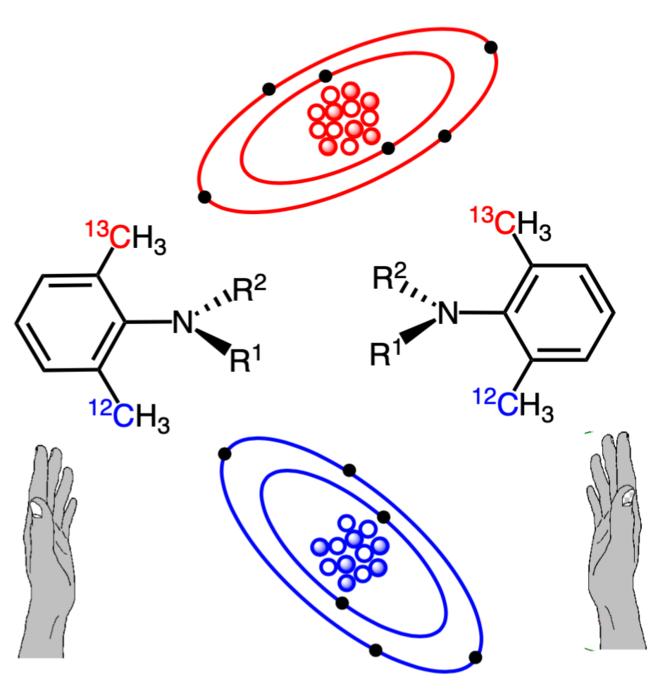In chemistry, a molecule or ion is said to be chiral if it cannot be superposed on to its mirror image by any combination of rotations, translations, or conformational changes. A chiral molecule or ion exists in two forms, called enantiomers, that are mirror images of each other; they are often distinguished as either ‘right-handed’ or ‘left-handed’ by their absolute configuration. Enantiomers exhibit similar physical and chemical properties, except when interacting with polarized light and reacting with other chiral compounds, respectively.

Credit: Professor Osamu Kitagawa from Shibaura Institute of Technology, Japan
In chemistry, a molecule or ion is said to be chiral if it cannot be superposed on to its mirror image by any combination of rotations, translations, or conformational changes. A chiral molecule or ion exists in two forms, called enantiomers, that are mirror images of each other; they are often distinguished as either ‘right-handed’ or ‘left-handed’ by their absolute configuration. Enantiomers exhibit similar physical and chemical properties, except when interacting with polarized light and reacting with other chiral compounds, respectively.
In recent years, isotopically chiral compounds, based on the discrimination of isotopes of an element, have generated considerable interest in structural and synthetic organic chemistry, medicinal chemistry, and fundamental reaction mechanisms due to their novel properties and potential applications. Numerous optically active isotopic molecules with an asymmetric carbon have been synthesized based on hydrogen/deuterium (H/D) discrimination. However, the synthesis, detection, and characterization of isotopic atropisomers—stereoisomers resulting from hindered rotation about single bonds, wherein the steric strain barrier to rotation is high enough to allow for the isolation of the conformers—is particularly challenging. To date, a handful of such molecules based on H/D discrimination have been reported.
Recently, a team of researchers, led by Professor Osamu Kitagawa of the Department of Applied Chemistry at the Faculty of Engineering at the Shibaura Institute of Technology in Japan, has successfully demonstrated the asymmetric synthesis of isotopic atropisomers based on the discrimination of carbon isotopes. Their work was made available online in The Journal of Organic Chemistry on 10 June 2023. It was co-authored by Ryunosuke Senda and Yuka Watanabe, graduate students at the Department of Applied Chemistry, Shibaura Institute of Technology.
Taking inspiration from their previous work (J. Org. Chem. 2022, 87, 13501) on the synthesis of CH3/CD3-atropisomeric quinazolin-4-one derivative, the team successfully prepared both enantiomers of 2-ethyl quinazolin-4-one with isotopic atropisomerism (N–C axial chirality) based on ortho-12CH3/13CH3 discrimination. They achieved this feat via an asymmetric synthesis method involving Suzuki–Miyaura cross-coupling. “The synthesized isotopic atropisomers based on 12C/13C discrimination were cryptochiral compounds having no optical rotation,” points out Prof. Kitagawa.
Since the researchers could not verify the existence of isotopic atropisomerism in the above-mentioned molecules, they further synthesized diastereomeric 3-aryl quinazolin-4-one derivatives possessing an asymmetric carbon atom along with isotopic atropisomerism. The diastereomers could be clearly distinguished (and the isotopic atropisomerism could be verified) using 1H and 13C nuclear magnetic resonance. They also exhibited high enantiomeric and diastereomeric stereochemical purity and rotational stability. Therefore, diastereomeric 3-aryl quinazolin-4-ones are an excellent scaffold for verifying diverse isotopic atropisomers.
Taken together, the novel findings of this research are bound to enrich our fundamental understanding of isotopic atropisomers, with positive implications in organicand medicinal chemistry. “This work reports the first isotopic atropisomers based on 12C/13C discrimination, which could potentially kindle academic curiosity in researchers to conduct similar studies in fundamental organic chemistry,” notes an optimistic Prof. Kitagawa.
***
Reference
DOI: https://doi.org/10.1021/acs.joc.3c01004
About Shibaura Institute of Technology (SIT), Japan
Shibaura Institute of Technology (SIT) is a private university with campuses in Tokyo and Saitama. Since the establishment of its predecessor, Tokyo Higher School of Industry and Commerce, in 1927, it has maintained “learning through practice” as its philosophy in the education of engineers. SIT was the only private science and engineering university selected for the Top Global University Project sponsored by the Ministry of Education, Culture, Sports, Science and Technology and will receive support from the ministry for 10 years starting from the 2014 academic year. Its motto, “Nurturing engineers who learn from society and contribute to society,” reflects its mission of fostering scientists and engineers who can contribute to the sustainable growth of the world by exposing their over 8,000 students to culturally diverse environments, where they learn to cope, collaborate, and relate with fellow students from around the world.
Website: https://www.shibaura-it.ac.jp/en/
About Osamu Kitagawa from SIT, Japan
Osamu Kitagawa is a professor at the Department of Applied Chemistry at the Shibaura Institute of Technology since April 2010. He graduated from the Department of Pharmaceutical Sciences at the Faculty of Pharmaceutical Sciences at Tokyo University of Pharmacy in March 1984 and acquired his pharmacist license at the same time. Henceforth, he pursued his doctoral studies in the same graduate school and acquired a Ph.D. in Pharmacy in March 1989. His research work primarily revolves around the creation and highly selective synthesis of novel stereoisomeric molecules and their synthetic chemical applications. He has published over 110 articles, which have been cited more than 4,000 times.
Funding Information
This work was partly supported by a research grant from Nagase Science and Technology Foundation.
Journal
The Journal of Organic Chemistry
DOI
10.1021/acs.joc.3c01004
Method of Research
Experimental study
Subject of Research
Not applicable
Article Title
Synthesis of Isotopic Atropisomers Based on 12C/13C Discrimination
Article Publication Date
10-Jun-2023
COI Statement
N/A




